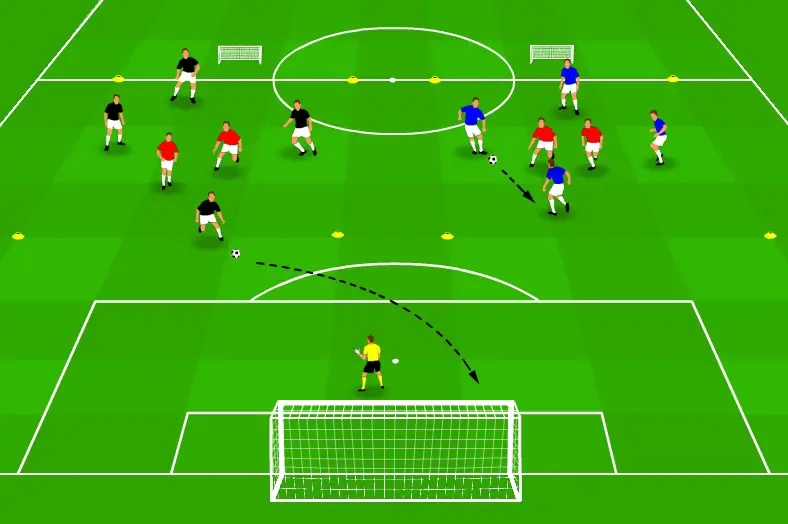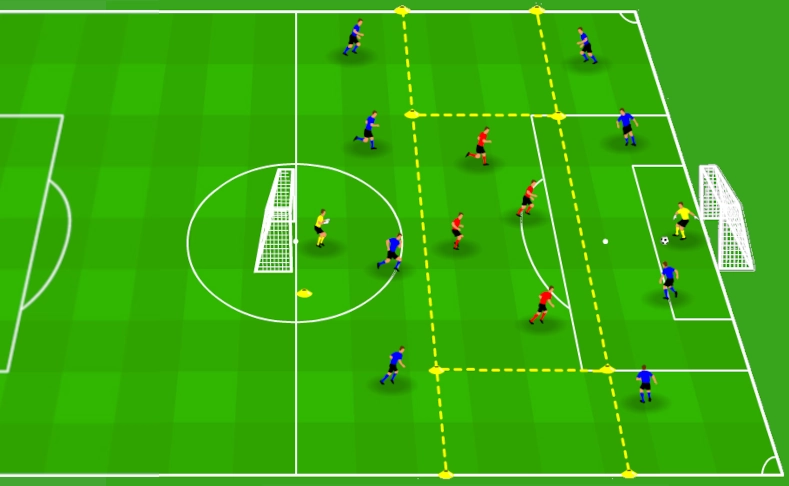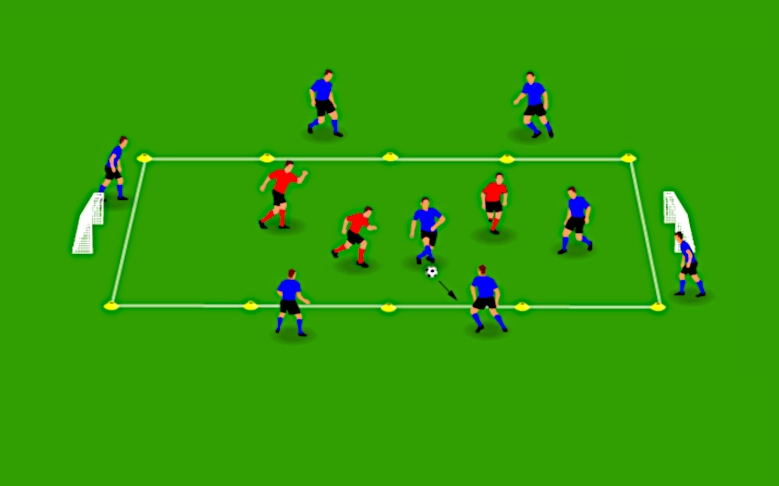Passing drill – Rondo with goals

Rondos are a great drill to warm up and improve passing skills. Unfortunately, players can get a bit bored of repeating the same old passing drill and eventually won’t take it seriously. This post goes over a variation of the old rondo that will keep players interested.
Setup
You will need half of an actual football pitch, 8 cones, 2 small goals and 2 balls. Set two rondo zones and their respective small goals as shown in the picture.
This drill works best with 3 teams of 4 players each and a goalkeeper, but you could involve a few more players. You can also have two groups and run this drill in both halves of the field. Use this drill as a warm-up.
Instructions
Although the list below may look complicated, this is a simple drill made up of two rondos running in parallel. In addition to the usual rondo rules, follow these basic instructions:
- The drill requires 3 teams. Assign one team to each zone to keep control of the ball (blue and black team in the picture) and split the other team in two (2 players in each zone) to challenge the ball.
- A classic rondo is played in each zone and players cannot change zones.
- Players keeping control of the ball are only allowed 2 touches: control and pass.
- Once the team in possession of the ball has passed the ball between all the players, the player with the ball may choose to make a run to the big goal to score or continue passing the ball.
- Once a player is running towards the goal, they cannot pass the ball to a teammate. Additionally, if a team is allowed to shoot and a player touches the ball more than two times, they must run to the goal and cannot pass the ball anymore.
- The team trying to recover the ball can attempt tackling the player that is running to the goal. However, defending players can only challenge inside their designated zone.
- The player attempting to score in the big goal must score or their team will lose possession of the ball.
- If a defender recovers the ball, they must control it and score in the small goal for their team to swap roles and become the team keeping possession.
- The defending players can only touch the ball 3 times: interception, control and passing or shooting to the small goal.
- When the defending team recovers possession in either zone, players in the other zone will join the players that recovered the ball in their zone to become the team in possession of the ball. The team losing possession is split in two and its players become defenders in each zone.
- The drill finishes either on a set time (e.g.: 15 minutes) or when a team reaches a target number of goals in the big goal (e.g.: 5 goals)
Takeaways
Rondos improve technique in tight areas, encourages intelligent movement and automate passing the ball in triangles. From a defensive point of view, rondos teach to press, closing down passing lanes and reading the intentions of the player on the ball. With addition of goals, this passing drill becomes more competitive and introduce other skills:
- Fitness. Introducing goals make a rondo very competitive, and in turn, increases the intensity. This game is physically demanding, particularly for the defending team.
- Passing. Because of the limitations imposed by the number of touches, players must improve their passing technique. In addition, players can only score after everyone has touched the ball. Therefore, the only way of winning in this game is by players improving their passing technique.
- Finishing. Players must improve their finishing technique either to maintain or regain possession. They can use power on the big goals, but need to be clinical when trying to score in the small goals.
- Teamwork. Rondos encourage teamwork over individual efforts. Players have to coordinate their movements to keep or regaining possession.
- Transitioning from defence into attack. The objective of the defensive team is to score goals too but in a different way. Therefore is not enough to intercept the ball by kick it high and out. The defensive team must control the ball to pass it or score in the small goals.
Final tips
This passing drill will be messy the first time you execute it. Don’t worry and keep the intensity. Don’t aim at getting a smooth transition between phases, focus on continuous movement as fast as possible. Your players will get better at it as they get the idea and rhythm. Perfection is not the objective, your main objective is to keep everyone moving.
If two players run towards the goal simultaneously, they should not wait for the goalkeeper to be ready. The idea is not only to keep moving but to force the keeper to have kick reactions. This will be useful in real scenarios where the goalie stops a shot but the ball bounces straight to another striker.



